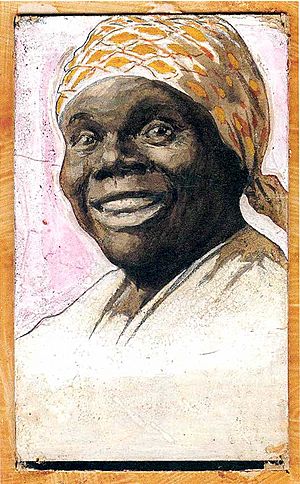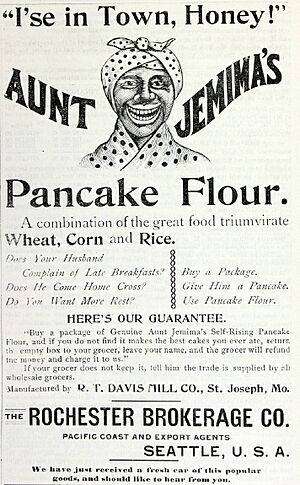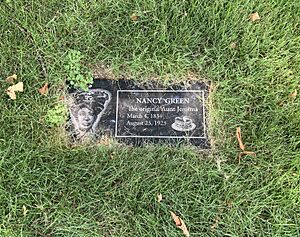Nancy Green facts for kids
Quick facts for kids
Nancy Green
|
|
|---|---|

Portrait of Green as Aunt Jemima
|
|
| Born | March 4, 1834 Kentucky, U.S.
|
| Died | August 30, 1923 (aged 89) Chicago, Illinois, U.S.
|
| Occupation | Nanny, cook, model |
| Known for | Aunt Jemima |
Nancy Green (born March 4, 1834 – died August 30, 1923) was an American woman. She was born into slavery. Later, she became famous as "Aunt Jemima". She was one of the first African-American models hired to promote a company's product. The well-known Aunt Jemima pancake recipe was not hers. However, Nancy Green became the first living person to represent a brand in advertising.
Contents
Nancy Green's Early Life
Nancy Hayes (or Hughes) was born into slavery on March 4, 1834. This happened in the Antebellum South, a time before the American Civil War. Oral history says she was born on a farm in Montgomery County, Kentucky. She had at least two children with George Green.
Nancy Green worked for Charles Morehead Walker and his wife Amanda. She was a servant, nurse, nanny, housekeeper, and cook. She also cared for their children as they grew up. The Walker sons later became a judge and a doctor in Chicago.
By the end of the American Civil War, Nancy Green had lost her husband and children. She moved with the Walker family from Kentucky to Chicago in the early 1870s. They settled in an area called the "Kentucky Colony." Many people from Kentucky lived there.
Becoming Aunt Jemima
Judge Walker recommended Nancy Green for a job. The R.T. Davis Milling Company hired her in St. Joseph, Missouri. They wanted her to represent "Aunt Jemima". This was an advertising character. The character was named after a song from a minstrel show. The company was looking for someone to promote their pancake mix.
Nancy Green was 59 years old when she first appeared as Aunt Jemima. This was at the 1893 World's Columbian Exposition in Chicago. She stood next to a giant flour barrel, which was 24 feet tall. There, she cooked pancakes, sang songs, and told stories. She described the Old South as a happy place for everyone.
After the Expo, it was said that Green was offered a lifetime contract. This was to continue promoting the pancake mix. However, this offer was likely part of the story created for the character. It was not a real contract for Nancy Green herself. This was the start of a big advertising effort. It included many public appearances and Aunt Jemima products. She visited fairs, festivals, and grocery stores. Billboards announced her arrival with the words, "I's in town, honey."
She played the role for about 20 years. She did not travel to the 1900 Paris exhibition. Another woman, Agnes Moodey, took her place there.
In 1910, at age 76, Nancy Green was still working as a housekeeper. Few people knew about her role as Aunt Jemima. She lived with her nieces and nephews in Chicago. When she passed away, she was living with her great-nephew.
Community Work and Beliefs
Nancy Green was very active in the Olivet Baptist Church in Chicago. During her lifetime, this church grew very large. It became the biggest African-American church in the United States. It had over 9,000 members at that time.
She used her public role to speak out against poverty. She also supported equal rights for people in Chicago.
Nancy Green's Death
Nancy Green died on August 30, 1923. She was 89 years old. This happened in Chicago. A car crashed into a laundry truck. The car then went onto the sidewalk where she was standing.
She was buried in a simple grave. It was near a wall in Oak Woods Cemetery in Chicago.
Finding Her Grave
For many years, her grave was unmarked and unknown. Sherry Williams, who started the Bronzeville Historical Society, spent 15 years searching for Green's resting place. Williams received permission to place a headstone. She asked Quaker Oats if they would help pay for a monument. The company said that Nancy Green and Aunt Jemima were not the same. They said Aunt Jemima was a made-up character.
The headstone was finally placed on September 5, 2020.
Lawsuit About Aunt Jemima
In 2014, a lawsuit was filed against Quaker Oats and PepsiCo. The lawsuit claimed that Nancy Green and Anna Short Harrington (who played Aunt Jemima starting in 1935) were not fairly paid. The people who filed the lawsuit were great-grandsons of Anna Short Harrington. They wanted money for the families of Green and Harrington. The lawsuit was later dismissed in February 2015.
See also
 In Spanish: Nancy Green para niños
In Spanish: Nancy Green para niños



